Further reading →
An introduction
In June 2022, we put into motion global diversity monitoring surveys. In some of our markets we utilised the Peakon Employee Voice and Workday survey platforms, for the purposes and context of this report we will call those surveyed through Peakon, ‘Lush Group and Partners.’
The Lush Group and Lush Partner markets that took part included Australia, Bahrain, Croatia, Czech Republic, Estonia, Hong Kong & Macau, Kuwait, Lebanon, Malaysia, New Zealand, Norway, Portugal, Serbia, Singapore, Slovenia, South Korea, Spain, Sweden, The Netherlands, United Arab Emirates, United Kingdom & Republic of Ireland.
In Lush North American markets, Canada and the United States of America, we ran the demographic survey using an inhouse platform. North American markets are also a part of the Lush Group, however they are not captured under ‘Lush Group and Partners’ in this report.
The Lush Group and Partners demographic survey was sent to 6108 employees to voluntarily complete. The questions were each optional, meaning respondents could answer all, some or none of the demographic questions. ‘Gender’ was the most responded to question at 49.98% response rate (3053 out of 6108 Lush colleagues chose to answer this question). The overall response rate averaged at 42.78%.
The Lush North American demographic survey was sent to 2972 employees to voluntarily complete. There were 1386 responses, at an overall response rate of 46.64%.
To accurately gather Lush Group leadership demographic data, we utilised Google forms to directly survey attendees of Lush leadership meetings, which happen on a twice weekly basis. The attendees include Founders, Directors, Senior Leads and Heads of Departments from across the Lush global business. The total number of regular attendees is 67, however not every attendee is in a senior leadership position, and will be in attendance for support or communication purposes. Of the 67 regular leadership attendees, 43 filled out the demographic survey, with an overall response rate of 64.71%. We are confident that we have captured all Lush Group leadership for this report.
It is important to note that self-identification was used throughout the surveys. We asked demographic questions on age, gender, sexuality, race and ethnicity, religion and belief, disability and chronic illness, neurodiversity, and education. The information for Lush Group and Partners for age demographics was amalgamated from employee records.
The Peakon and Workday survey platform allowed for respondents to choose one option per question, and there was no room for open box answers. To manage this, the option to notify if a respondent’s identity demographic was not listed was available. You can see this data compiled throughout the report as ‘not listed.’ The Google Leadership demographic survey mirrored the Peakon survey. The programme used in North America allows for multi-select and open box responses, and therefore the data sits separately from the rest of Lush Group to ensure accuracy in reporting. As a result of offering the ability to multi-select or open box responses, North American percentages may not total to 100%. There is more on this included in the ‘Learnings on Collecting Demographic Data’ section under the report summary.
The aim of the surveys is to understand diversity across the global Lush business. This report states the findings and figures from the surveys. This report is part of a commitment to regularly monitor and measure diversity at Lush, to offer transparency about who we are at Lush, and continuously work towards the goal of diversifying the Lush business. All are welcome, always.
Age – Lush Group and Partners
This data was collected through employee records, and not as part of the demographic survey due to the Peakon function to include birth date data. The information collected here includes Group and Partner markets listed in the introduction.
Age by Business Area – Lush Group and Partners
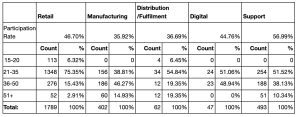
Generation – Lush North America
This data was collected through the demographic survey sent to Lush colleagues in Canada and the United States of America in June 2022. Each survey respondent was given the option to identify the year born within a range (generation).
Generation by Business Area – Lush North America
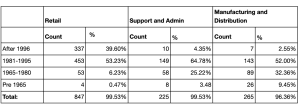
Age – Lush Group Leadership
This data was collected through the demographic survey sent to Lush Global leadership in October 2022. Each respondent was given the option to identify their age group.
Gender – Lush Group and Partners
This data was collected through the demographic survey sent to Lush colleagues in the Group and Partner markets listed in the Introduction in June 2022. Each survey respondent was given the option to identify their gender with two sections labelled ‘gender’ and ‘gender further information’. In the tables on the right, you can find how many respondents replied per option. The two sections each had an individual response rate, as seen in the top of each table.
Gender – Lush North America
This data was collected through the demographic survey sent to Lush colleagues in Canada and the United States of America in June 2022. Each survey respondent was given the option to identify their gender identity and gender description. In the tables alongside, you can find how many respondents replied per option. The two sections each had an individual
response rate, as seen in the top of each table.
Gender – Lush Group Leadership
This data was collected through the demographic survey sent to Lush global leadership in October 2022. Each survey respondent was given the option to identify their gender with two sections labelled ‘gender’ and ‘gender – further information’. In the tables below, you can find how many respondents replied per option.
Sexuality – Lush Group and Partners
This data was collected through the demographic survey sent to Lush colleagues in the Group and Partner markets listed in the Introduction in June 2022. Each survey respondent was given the option to identify their sexuality. In the table below, you can find how many respondents replied per option. The response rate for this section is seen at the top of the table.
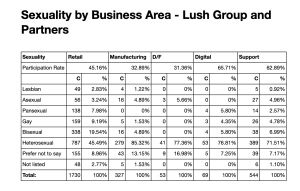
Sexuality – Lush North America
This data was collected through the demographic survey sent to Lush colleagues in Canada and the United States of America in June 2022. Each survey respondent was given the option to identify their sexuality. In the table below, you can find how many respondents replied per option. The response rate for this section is seen at the top of the table.
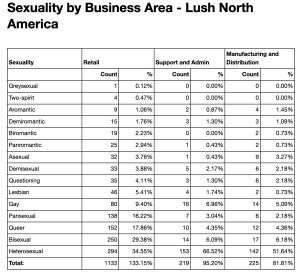
Sexuality – Lush Group Leadership
This data was collected through the demographic survey sent to Lush global leadership in October 2022. Each survey respondent was given the option to identify their sexuality. In the table below, you can find how many respondents replied per option.
Race and Ethnicity – Lush Group and Partners
This data was collected through the demographic survey sent to Lush colleagues in the Group and Partner markets listed in the Introduction. Each survey respondent was given the option to identify their race and/or ethnicity. In the table below, you can find how many respondents replied per option. The response rate for this section is seen at the top of the table.
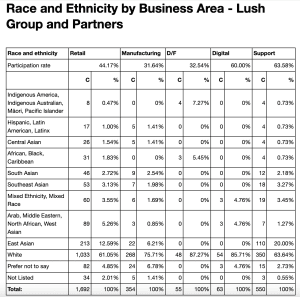
Race and Ethnicity – Lush North America
This data was collected through the demographic survey sent to Lush colleagues in Canada and the United States of America in June 2022. Each survey respondent was given the option to identify their race and/or ethnicity. In the table below, you can find how many respondents replied per option. The response rate for this section is seen at the top of the table.
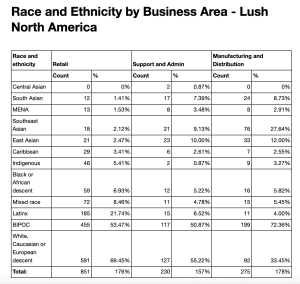
Race and Ethnicity – Lush Group Leadership
This data was collected through the demographic survey sent to Lush global leadership in October 2022. Each survey respondent was given the option to identify their race and/or ethnicity. In the table below, you can find how many respondents replied per option.
Religion and Belief – Lush Group and Partners
This data was collected through the demographic survey sent to Lush colleagues in the Group and Partner markets listed in the Introduction in June 2022. Each survey respondent was given the option to identify their religion and/or belief. In the table below, you can find how many respondents replied per option. The response rate for this section is seen at the top of the table.
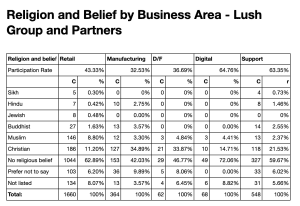
Religion and Belief – Lush North America
This data was collected through the demographic survey sent to Lush colleagues in Canada and the United States of America in June 2022. Each survey respondent was given the option to identify their religion and/or beliefs. In the table below, you can find how many respondents replied per option. The response rate for this section is seen at the top of the table.
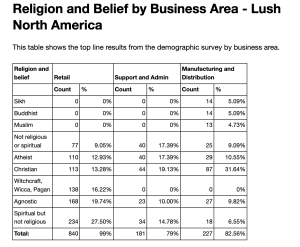
Religion and Belief – Lush Group Leadership
This data was collected through the demographic survey sent to Lush global leadership in October 2022. Each survey respondent was given the option to identify their religion and/or belief. In the table below, you can find how many respondents replied per option.
Disability and Chronic Illness – Lush Group and Partners
This data was collected through the demographic survey sent to Lush colleagues in the Group and Partner markets listed in the Introduction in June 2022. Each survey respondent was given the option to identify their disability and/or chronic illness with two sections labelled ‘disability’ and ‘chronic illness’. In the tables below, you can find how many respondents replied per option. The two sections each had an individual response rate, as seen in the top of each table.
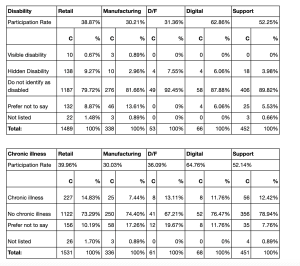
Neurodiversity – Lush Group and Partners
This data was collected through the demographic survey sent to Lush colleagues in the Group and Partner markets listed in the Introduction in June 2022. Each survey respondent was given the option to identify as neurodivergent (such as autism, ADHD, ADD or any other neurodivergence) or neurotypical in the section labelled ‘neurodiversity’. In the table below, you can find how many respondents replied per option. The response rate for this section is seen at the top of the table.
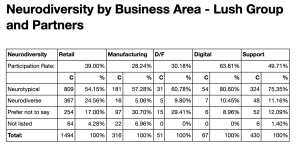
Disability, Chronic Illness and Neurodiversity – Lush North America
This data was collected through the demographic survey sent to Lush colleagues in Canada and the United States of America in June 2022. Each survey respondent was given the option to identify their ability status, and the visibility of their status. In the tables below, you can find how many respondents replied per option. The response rates for this section are
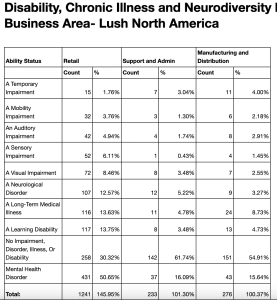
Disability and Chronic Illness – Lush Group Leadership
This data was collected through the demographic survey sent to Lush Global leadership in October 2022. Each survey respondent was given the option to identify their disability and/or chronic illness with two sections labelled ‘disability’ and ‘chronic illness’. In the tables below, you can find how many respondents replied per option.
Neurodiversity – Lush Group Leadership
This data was collected through the demographic survey sent to Lush global leadership in October 2022.Each survey respondent was given the option to identify as neurodivergent (such as autism, ADHD, ADD or any other neurodivergence) or neurotypical in the section labelled ‘neurodiversity’. In the table below, you can find how many respondents replied per option.
Education – Lush Group and Partners
This data was collected through the demographic survey sent to Lush colleagues in the Group and Partner markets listed in the Introduction in June 2022. Each survey respondent was given the option to identify their educational background. In the table below, you can find how many respondents replied per option. The response rate for this section is seen at the top of the table.
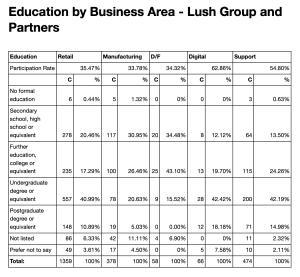
Education – Lush North America
This data was collected through the demographic survey sent to Lush colleagues in Canada and the United States of America in June 2022. Each survey respondent was given the option to identify their educational background. In the table below, you can find how many respondents replied per option. The response rate for this section is seen at the top of the table.
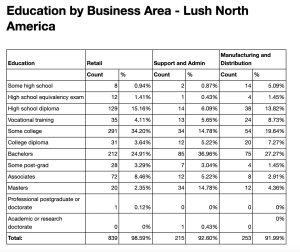
Education – Lush Group Leadership
This data was collected through the demographic survey sent to Lush global leadership in October 2022. Each survey respondent was given the option to identify their educational background. In the table below, you can find how many respondents replied per option.
We acknowledge that the data is not complete as this is our first Lush global demographic survey. We began the project with the ambition of surveying all Lush markets to get a snapshot of who makes up the global Lush business. However, due to the personal and sensitive nature of data we were gathering, we quickly learnt that differing legal parameters in place made surveying in every Lush market difficult.
Where we could run the survey across Lush markets, we had to factor in the importance of translations and comparability. We understood that the importance of terminology and language to identity was vital, and the room to self-identify was a priority in this survey. We collaborated with colleagues in each market locally to ensure this information was reaching colleagues in an appropriate and helpful way.
We utilised Peakon Employee Voice and Workday programmes to run the survey across some of our global markets, including those listed in the introduction under Lush Group and Partners. We based this decision on working with a familiar organisation, as we have previously ran Lush Listens engagement surveys through the Peakon platform. The thinking was to limit the places we gather and store Lush employee data, to keep the data safe and secure. Peakon, designed as an engagement platform, has limits to offering open box responses for the demographic survey. We managed this by allowing respondents to notify if their identity was not listed. As well as this, respondents were only able to select one option per section. We have learnt that we can improve the selection basis for future demographic surveys, for both the accuracy of the data collected and for the experience of the respondents.
We used a different in-house programme for our North American markets to run the demographic survey. This allowed for multi-select and open box responses. The function of multi-select and open box responses is to acknowledge that people’s identities do not neatly fit into tick boxes. Whilst grouping demographic information is useful for understanding who is represented at Lush, multi-select and open box responses enable Lush colleagues to comfortably identify across multiple groupings, or to comfortably describe their identities in their own words. The goal is to make this available for all Lush global colleagues with future surveying, as the user experience of the survey is important for the data that is produced.
Future Goals for Surveying
Diversity enriches our lives and our business, and our future aim is to continue to regularly capture Lush’s diversity and representation data.
The purpose of this report is to offer transparency about diversity and representation at Lush. With the data we have collected, we now understand that transparency is a goal in and of itself, and we will continue to work towards accurately reporting diversity at Lush. Moving forward, we now feel in a more informed position to approach this work.
As part of our future strategy we want to invest in and elevate employee voice, and make evidence-based decisions. Continued diversity monitoring will be a part of this approach to gather evidence. We have begun to use this information to analyse and compare alongside the responses to our Lush Listens engagement survey and our EBT scheme (*details below). This way we are capturing both who makes up Lush, and how they experience Lush as a workplace.
In North America specifically, we have been connecting identity to strategy and have already started utilising the data to shape our People & Culture practices from recruitment, to learning and development, to the benefits we offer our Lush staff. North America teams have made a commitment to share specific actions and plans to local colleagues in early 2023.
*The Lush Listens engagement survey is one part of championing employee voice, where all employees are asked to evaluate and comment on their experience and life inside Lush.
In 2017, we began an employee ownership scheme, Lush Employee Benefit Trust (EBT), across all of Lush’s 22 Group countries (those owned by Lush Ltd), where 10% of company shares are held on behalf of the staff. Because the EBT functions across continents and cultures, this gives Lush not just a global reach, but an accessible way to collaborate with employees.
We aim to actively create meaningful connections and a sense of belonging within Lush. We continue to work on growing our internal networks through dedicated spaces for community.
From September 2022, we were pleased to see the Lush UK&I market go into the second year of Community Networks, including networks for: Disability and Chronic Illness, People of the Global Majority, LGBTQIA+, Menopause, Menstruation, Neurodiversity, Parents and Carers, and Trans and Non-Binary colleagues.
Australia and New Zealand markets have launched their first community networking space with the LGBTQIA+ Community Network, and the North American markets are beginning to build their employee resource groups too.
We have begun working in a collaborative way through focus groups to diversify our products, now including Eid, Diwali and Hanukkah amongst seasonal ranges. Regular diversity monitoring will support us to understand what community and focus spaces can be provided and invested to contribute to inclusion and belonging at Lush.
This will be the company we want it to be.
12:11









